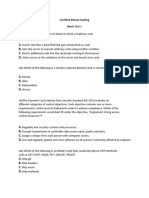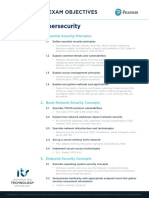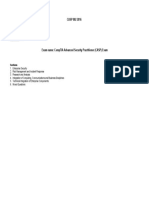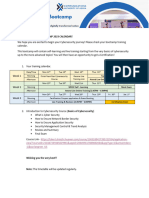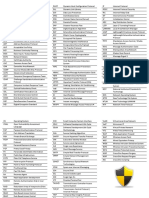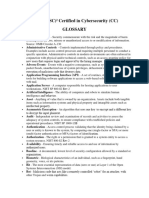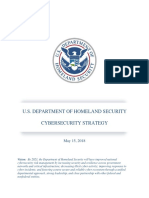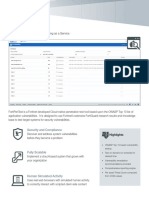ISC2 CC Final Revision Notes +
Confidence Cheat Sheet
🧠 ISC2 CC Final Revision Notes (with Examples)
Domain 1: Security Principles
CIA Triad:
- Confidentiality: Prevent unauthorized access (Ex: Using encryption on emails)
- Integrity: Ensure data is accurate and untampered (Ex: File hash checksums)
- Availability: Systems accessible when needed (Ex: Backups, redundant servers)
Key Principles:
- Least Privilege: Users get only what they need (Ex: HR can’t access firewall logs)
- Separation of Duties: Split responsibilities (Ex: One person creates users, another
approves them)
- Need to Know: Limits access based on relevance (Ex: Marketing can’t access payroll data)
Roles:
- Data Owner: Defines classification (e.g., Confidential)
- Custodian: Maintains data (e.g., backup admin)
- User: Uses data responsibly
Control Types:
- Administrative: Policies, training
- Technical: Firewalls, encryption
- Physical: Locks, guards, cameras
Risk:
- Risk = Threat × Vulnerability × Impact
- Example: Unpatched server + ransomware = High Risk
- Frameworks: NIST CSF, ISO 27001
Domain 2: Business Continuity, DR, and Incident Response
BCP vs DRP:
- BCP: Keeps business running (Ex: Remote work setup during disaster)
- DRP: Restores IT systems (Ex: Recovering data from backup)
�BIA:
- Identifies critical functions
- RTO: Recovery Time Objective – how soon to resume operations
- RPO: Recovery Point Objective – acceptable data loss
Incident Response Lifecycle:
1. Preparation – Plans and teams ready
2. Detection – Spotting the issue
3. Containment – Isolate the threat
4. Eradication – Remove the cause
5. Recovery – Restore operations
6. Lessons Learned – Improve
Testing:
- Tabletop: Discussion-based simulation
- Full-scale: Real simulated incident response
Domain 3: Access Control Concepts
IAAA:
- Identification: Claiming identity
- Authentication: Verifying identity (passwords, biometrics)
- Authorization: Granting permissions
- Accounting: Logging actions
Access Models:
- DAC: Owner grants permissions (Ex: File sharing)
- MAC: Based on sensitivity labels (Ex: Classified documents)
- RBAC: Based on role (Ex: HR = payroll only)
- ABAC: Based on attributes (Ex: Time, location)
MFA:
- At least 2 of: Something you know (password), have (token), are (biometric)
Domain 4: Network Security
OSI Layers:
1. Application – Email, browser
2. Presentation – Encoding, encryption
3. Session – Maintains communication
4. Transport – TCP/UDP
5. Network – IP, routing
�6. Data Link – MAC addresses
7. Physical – Cables, hardware
Protocols:
- SSH, SFTP, HTTPS, IPSec
Common Attacks:
- DDoS – Disrupt availability
- MITM – Intercept communication
- ARP Spoofing – Fakes MAC identity
- Phishing – Tricks users
Network Devices:
- Firewall – Filters traffic
- IDS/IPS – Detects/prevents threats
- VPN – Secure access
- Proxy – Intermediary for requests
Domain 5: Security Operations
SIEM (e.g., Splunk):
- Correlates logs, alerts on anomalies
Patch Management:
- Closes known vulnerabilities
Backup Types:
- Full: Everything
- Incremental: Since last backup
- Differential: Since last full
Secure Disposal:
- Wipe, degauss, shred
Awareness Training:
- Prevents phishing, teaches best practices
Physical Security:
- Locks, cameras, biometric access
�🧠 ISC2 CC Confidence Cheat Sheet – No More A/B Doubts
1. If two answers sound similar: Choose the one focused on control or risk reduction.
Example: Separation of Duties → A (reduce risk), not B (increase efficiency).
2. Trust ISC2 logic over real-world exceptions.
Awareness training → Helps reduce human error, not teaching programming.
3. One answer is usually more complete than the other. Pick based on goal alignment.
4. Be cautious of vague or overly permissive answers.
Avoid choices that say “all access,” “no controls,” “all users.”
5. Eliminate wrong answers fast with these red flags:
- "All users have access" → Violates least privilege
- "Improves efficiency" → Not a core security goal
- "No need to classify data" → Breaks data governance principles
6. Focus on what’s being asked – match keywords to correct category:
- Risk → Mitigate, reduce
- Access → Role, policy, control
- Network → Filter, encrypt, segment
- Ops → Monitor, log, patch
7. “Most appropriate” = the one that solves the issue in the best way for a secure
environment.
8. Reverse the question if stuck: “What would be the worst option here?”
Remember: You already know this — trust your instincts, eliminate fluff, and go with the
security-first logic.







